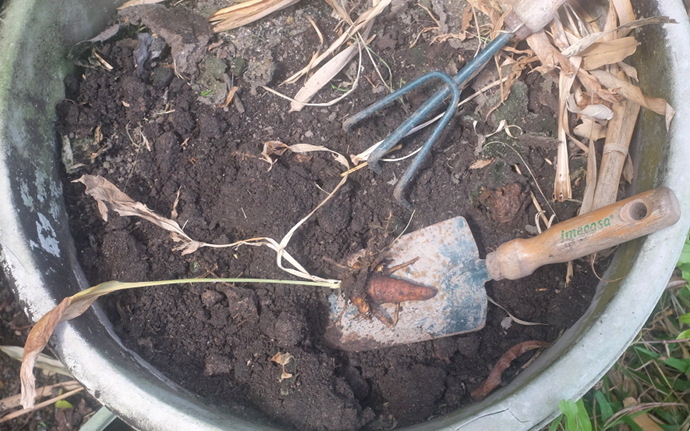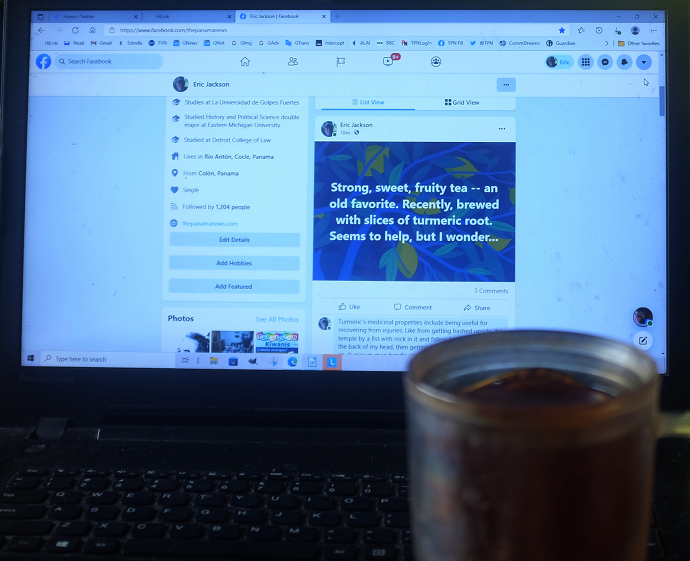The last of a season’s production when the editor used a lot. However, you cn buy turmeric roots in stores or from street vendors. Photo by Eric Jackson.
Medicinal plants and the structural reasons why questions go unresearched
by Eric Jackson
Strong, sweet, fruity tea — an old favorite. Recently, brewed with slices of turmeric root. Seems to help, but I wonder…
Turmeric’s medicinal properties include being useful for recovering from injuries. Like from getting bashed upside the temple by a fist with rock in it and falling back and hitting the back of my head, then getting beaten over the head with an aluminum mop handle several months ago.
The medical literature about turmeric that’s readily available online goes way, way back and is updated in many places. But scant is the stuff about counter-indications or reactions with other drugs or foods. When you think about it, that’s quite the indictment of capitalist medicine.
A few years back some dweeb claimed to have discovered the medicinal properties of turmeric and tried to patent it, and was shot down in a US patent court with the government of India and the German Greens joining in the opposition. The patent was not allowed.
SO, no corporate-sponsored tests to prove safety and efficacy to the FDA. No capitalist reason to look deeper into the properties of turmeric.
If I eat grapefruit and drink turmeric tea with my breakfast, will the grapefruit interfere with the effect of the turmeric? Or what if I slug down turmeric tea with a greasy bacon sandwich?
Or WHAT IF, I take some prescribed medicine, or over-the-counter medication like ibuprofren, with turmeric? Is there something I ought to know?
Similarly, what if I come down with COVID, having been drinking turmeric tea? Might it be counter-indicated by the disease? Would a physician evaluating my case want to take turmeric use into her or his diagnosis or prescription?
A few years back at one of the STRI Tuesday talks a German researcher spoke about work that he was doing in Germany, where herbal medicine is quite popular, on herbal cures’ relationships with industrial medicines.
It should be expected that China, with advanced traditional and global standard medical systems, ought to be a leader in such research.
However, the field is vast. In Panama alone there are at least seven sorts of traditional healing systems, one of which is Chinese. Or more than one, if you count acupuncture and Chinese herbal medicine as two.
It was, at one point anyway, of interest to the University of Panama and the Ministry of Health to begin a unification of knowledge and development of standards to certify traditional healers.
Then socialite dingbats meddled, supposing that cult beliefs like crystal healing were somehow as valid as the generations of knowledge that the inatuledes, jaibanas and botanicas* have learned.
I am not sure if the research and movements toward certification ever got back on track to continue. I do know that there are standard physicians who call it all quackery. Some of this is racism and some of it is a monopolistic attitude about healing. But it is a problem that anyone can call himself or herself an herbal healer no matter how much knowledge, and in light of an awful lot of nonsensical ideas floating around out there.
* Note: An inatulede is an advanced healer in the Guna tradition, while the Embera counterpart of sorts is a jaibana. A botanica is a woman who practices herbal healing, and a male colleague would be a botanico. Both inatuledes and jaibanas tend to start out as herbalists, but then advance into practices that will have psychological, sociological or religious apsects.
Contact us by email at fund4thepanamanews@gmail.com
To fend off hackers, organized trolls and other online vandalism, our website comments feature is switched off. Instead, come to our Facebook page to join in the discussion.
These links are interactive — click on the boxes













